Don't wanna be here? Send us removal request.
Text

Bis früh um Fünfe! (“Until 5 in the Morning”), realizzata nel 1922 da Ludwig Lutz Ehrenberger:
2 notes
·
View notes
Text

Marlene Dietrich
Freiherr (Baron) Wolff von Gudenberg (1890-1961 or 1964) was a photographer who was noted and fashionable in the 1920s and 1930s in Berlin. Wolff von Gudenberg is the name of an old Hessian noble family that was raised to the rank of baron in 1873. He photographed actors like Marlene Dietrich and Fritzi Massary, dancers like Marianne Winkelstern and La Jana, and international celebrities such as Josephine Baker and Anna May Wong. His photos appeared in magazines such as Die Dame, newspapers like Berliner Illustrirte Zeitung (BIZ), and on countless postcards by Ross Verlag and other publishers.
1 note
·
View note
Text

Born on this day. Otto Dix, 2 December 1891, Untermhaus, today a district of Gera - 25 July 1969, Singen am Hohentwiel, German painter and graphic artist of the 20th century. "He is one of the most important painters of Expressionism and New Objectivity in Germany. The Dresden-trained artist processed his experiences of the First World War in the graphic portfolio "The War" (50 etchings), expressive paintings such as "War Cripples" (lost), "The Trench" and the triptych "The War" (1929-1932, Dresden). During the Weimar Republic, Otto Dix advanced to become one of the most prominent portrait painters, capturing above all the bohemians and intellectuals of his time. The Nazis were one of the first to defame the academy professor in Dresden and withdraw his teaching licence. In Bavaria, Dix withdrew into inner emigration, but was allowed to continue painting Christian motifs. After the end of the Second World War, Otto Dix remained a figurative painter and received many honours and exhibitions in both the FRG and the GDR."
3 notes
·
View notes
Text

Otto Dix (German, 1891-1969) Triumph des Todes [Triumph of Death], 1933-1934. Mixed media on wood, 180 x 178 cm. Galerie der Stadt, Stuttgart
In April 1933, only a few months after Hitler assumed the Chancellorship of Germany, Otto Dix, one of Germany's leading artists, was dismissed from his position as professor at the Dresden Academy of Arts.
5 notes
·
View notes
Text

Karl Hofer (German, 1878-1955) Yellow Dog Blues, 1928. Oil/canvas, 140x94.5 cm. Private collection.
2 notes
·
View notes
Text
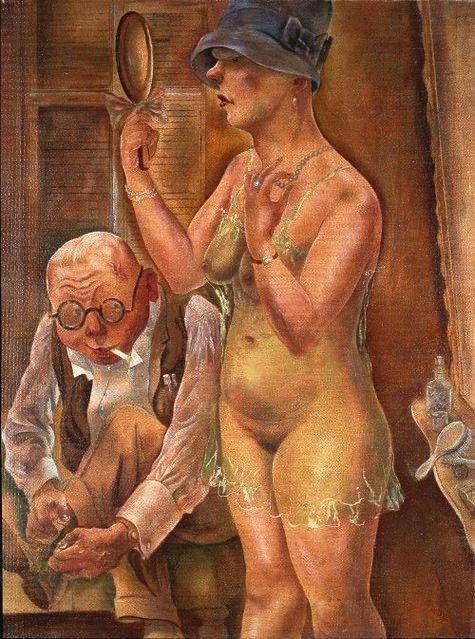
George Grosz (German, 1893-1959)
Mann und Frau (Man and Woman), 1926
10 notes
·
View notes
Text
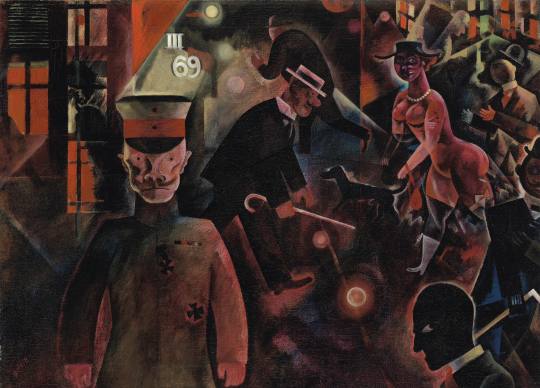
Gefährliche Straße (Dangerous Street) - George Grosz - 1918
A visionary fusion of Expressionist fervour and Cubo-Futurist fragmentation, these dynamic, angular cross-sections of gritty, urban form and imagery conjure a fractured and simultaneist image of war-time Berlin as a frenetic, bubbling cauldron of decadence, death, gaudy glamour and crime. Often suffused by an all-encompassing field of electric red light that falls over everything in the manner of Edgar Allen Poe’s story of the Masque of the Red Death, these hell-fire visions of city life offer a sequence of kaleidoscopic portraits of modernity gone mad. They are essentially, as the Expressionist poet, Theodor Däubler first championed them, ‘apocalyptic pictures’: dystopian visions of metropolitan life that reveal the Babylon of Berlin to be what another contemporary critic, (the writer and philosopher, Salomo Friedländer), wittily referred to as a ‘Dadantesque Inferno’.
Christie’s, London Oil on canvas 47.3 x 65.3 cm (18 5/8 x 25 ¾ in.)
9 notes
·
View notes
Text
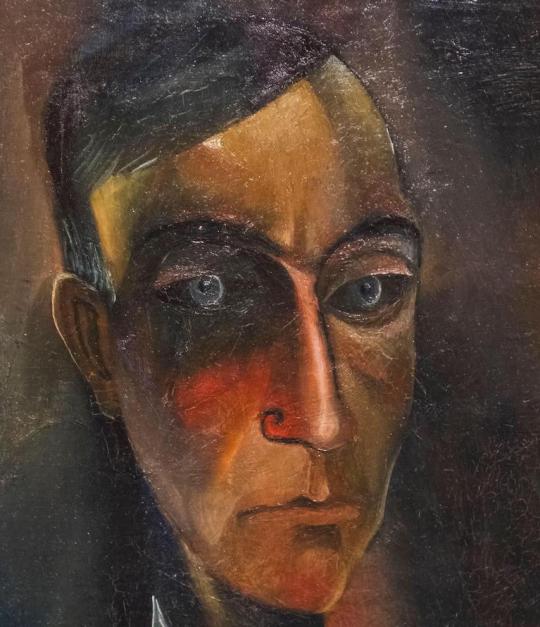
Born on this day. Carlo Mense, May 13, 1886, Rheine - August 11, 1965, Königswinter, German painter of Rhenish Expressionism and New Objectivity. He was a professor at the State Academy of Arts and Crafts in Breslau.
Self-Portrait, 1918
5 notes
·
View notes
Text
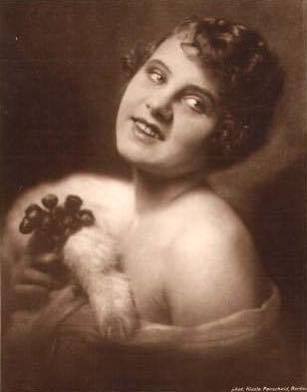
Accadde Oggi 1930 by Nicola Perscheid
L'attrice Ossi Oswalda , 1925-27
3 notes
·
View notes
Text
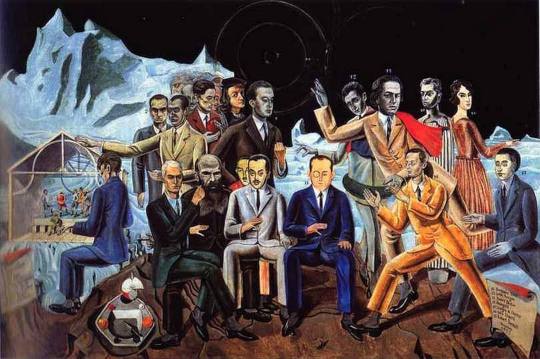
Max Ernst (German, 1891-1976) The Meeting of the Friends, 1922 Oil on canvas, 129.5 x 193 cm. Museum Ludwig, Cologne
Max and his Dada/Surrealist pals. Those pictured (from left to right by number): #1 - René Crevel (French writer, 1900-35) #2 - Philippe Soupault (French writer, poet, novelist, critic, and political activist, 1897-1990) #3 - Hans Arp (Alsatian sculptor, painter, poet and abstract artist, 1886-1966 -- co-founder of Dada movement) #4 - Max Ernst (seated, green jacket) #5 - Max Morise (French artist, writer & actor, 1900-73 -- standing, red jacket) #6 - Fyodor Dostoevsky! (the great Russian writer -- imaginary "friend" seated to right of Ernst) #7 - Raffaelo Sanzio! (Italian Renaissance great -- another imaginary "friend" standing to right of Morise) #8 - Théodore Fraenkel (French writer, seated w/ red jacket) #9 - Paul Éluard (French surrealist poet, 1895-1952 -- standing, brown jacket) #10 - Jean Paulhan (French writer, literary critic and publisher, director of the literary magazine Nouvelle Revue Française, 1884-1968 -- seated, beige jacket) #11 - Benjamin Péret (French surrealist poet, 1899-1959 -- guy with monocle) #12 - Louis Aragon (French poet and novelist, 1897-1982 -- Future surrealist "boss man" & Stalinist) #13 - André Breton (French writer, poet, and surrealist theorist, 1896-1966 -- Principal founder of Surrealism) #14 - Johannes Theodor Baargeld (German painter and poet, 1892-1927 -- in front of Breton) #15 - Giorgio de Chirico (Italian proto-surrealist painter, 1888-1978) #16 - Gala Éluard (1892-1964, the "surrealist Madonna" -- wife of Paul Éluard and then Salvador Dali!) #17 - Robert Desnos (French surrealist poet, 1900-45)
6 notes
·
View notes
Text

Die Elektrische - Otto Dix - 1919
The present work was executed in 1919, the year in which Otto Dix became a founding member of the Dresden 'Secession Group 1919'. This idiosyncratic and pivotal work draws heavily on Dadaism with its collaged elements. The combination of painterly texture and the magpie-like inclusion of found objects epitomises one of the defining dialogues of modernism as the artist moved increasingly towards such Dadaist tactics for a short while, particularily during the following year when he became friends with George Grosz. This bold new style found many supporters, including the renowned art dealer, Johanna Ey, the first owner of the present work. Ey's longstanding patronage of the avant-garde helped to gain them international recognition, and not before long Dix's extraordinary experiments caught the attention of other Dada artists such as Kurt Schwitters, whose own distinctive style would soon come to define the movement.
Oil and assemblage on panel 46 x 37cm (18 1/8 x 14 5/8 in.
17 notes
·
View notes
Text
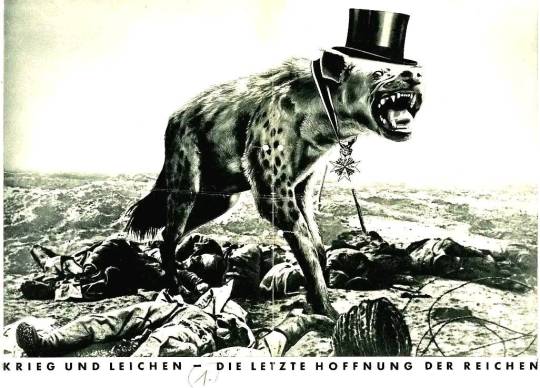
Krieg und Leichen - Die letzte Hoffnung der Reichen (War and Corpses - The last Hope of the Rich) John Heartfield, 1932
2 notes
·
View notes
Text
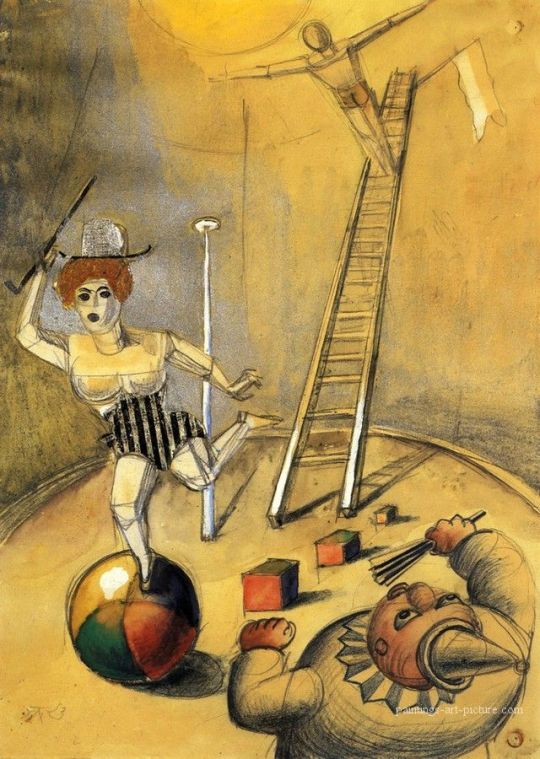
Otto Dix (German. 1891-1969) Zirkusscene (Circus Scene), 1923. Watercolor, coloured chalk, sprayed silver bronze, pencil and collage on paper. @Sold at auction Dec. 03, 2020
10 notes
·
View notes
Text
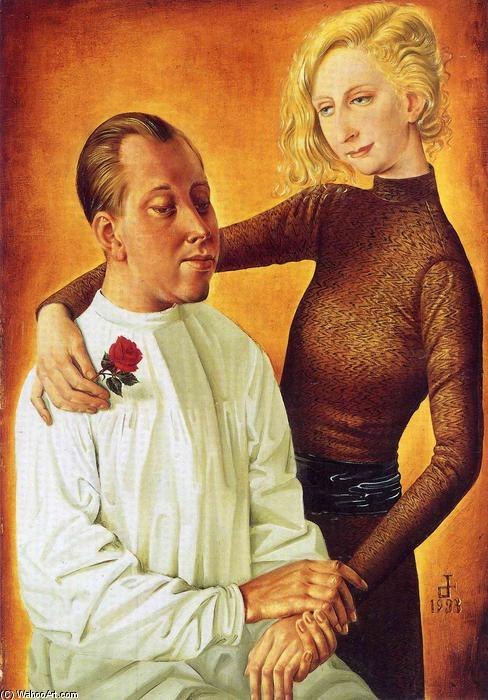
Otto Dix (German, 1891-1969) Portrait of the Painter Hans Theo Richter and his Wife Gisela, 1933
5 notes
·
View notes
Text
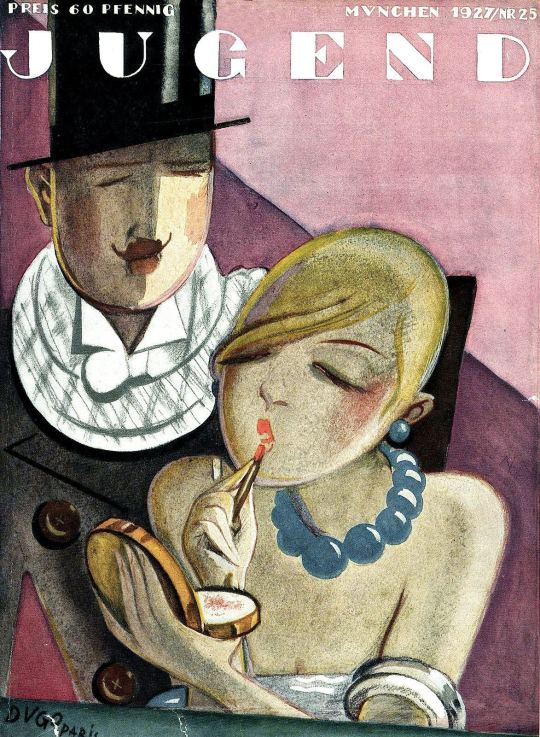
Cover of Jugend magazine, 1927
Jugend (German for 'Youth') (1896–1940) was an influential German arts magazine. Founded in Munich by Georg Hirth who edited it until his death in 1916, the weekly was originally intended to showcase German Arts and Crafts, but became famous for showcasing the German version of Art Nouveau instead. It was also famed for its "shockingly brilliant covers and radical editorial tone" and for its avant-garde influence on German arts and culture for decades, ultimately launching the eponymous Jugendstil ('Youth Style') movement in Munich, Weimar, and Germany's Darmstadt Artists' Colony.
4 notes
·
View notes
Text
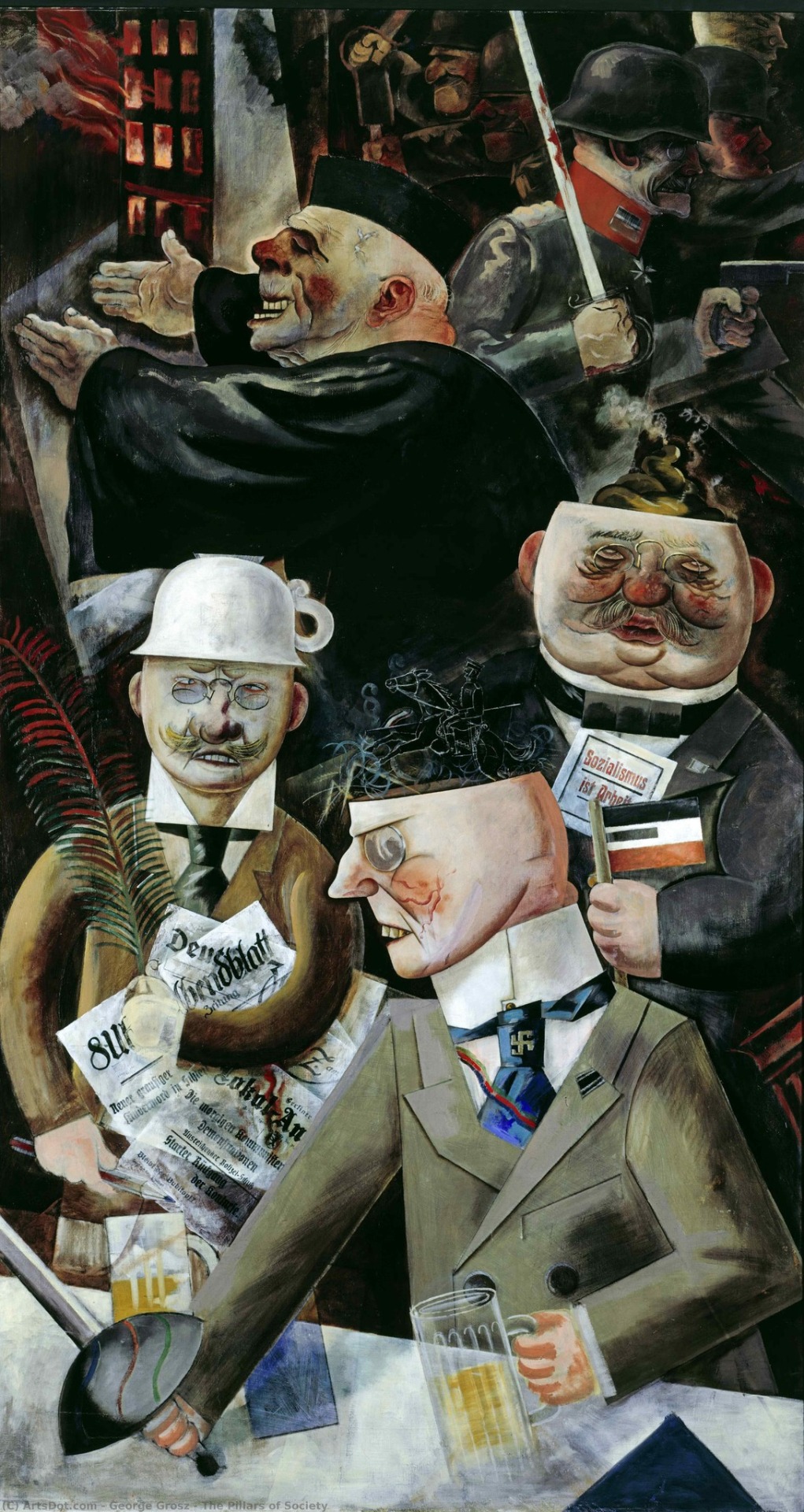
George Grosz Pillars of Society (1926) Oil on canvas, 108 x 200 cm
The painting is a deeply sarcastic portrait of the German elite classes that supported fascism. Like many of his paintings from this era he satirized what he believed to be Germany's corrupt, bourgeois society. In this painting Grosz uses his skills as a caricaturist to produce vivid, grotesque, marbled portraits of those who controlled society. Businessmen, clergy and generals, are all depicted not as the polished, refined gentlemen of the Academy's art, but as vicious, selfish, hardened individuals
20 notes
·
View notes
